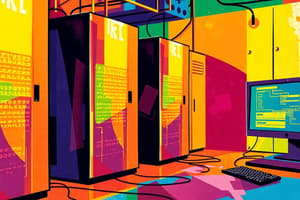Podcast
Questions and Answers
¿Cuál es el tipo de red que conecta dispositivos en un área geográfica limitada?
¿Cuál es el tipo de red que conecta dispositivos en un área geográfica limitada?
- WAN
- Internet
- LAN (correct)
- WLAN
¿Qué es el objetivo principal del estudio de la interacción humano-computadora?
¿Qué es el objetivo principal del estudio de la interacción humano-computadora?
- Crear sistemas de computadora más veloces
- Animar a los usuarios a utilizar computadoras
- Diseñar interfaces de usuario intuitivas (correct)
- Desarrollar software de código abierto
¿Cuál es el protocolo de red más comúnmente utilizado en Internet?
¿Cuál es el protocolo de red más comúnmente utilizado en Internet?
- SMTP
- FTP
- HTTP
- TCP/IP (correct)
¿Cuál de los siguientes no es un principio de diseño de HCI?
¿Cuál de los siguientes no es un principio de diseño de HCI?
¿Qué es un ejemplo de interacción de lenguaje natural?
¿Qué es un ejemplo de interacción de lenguaje natural?
¿Cuál es el primer paso en el proceso de diseño de HCI?
¿Cuál es el primer paso en el proceso de diseño de HCI?
¿Cuál es el proceso de organización de datos en una base de datos?
¿Cuál es el proceso de organización de datos en una base de datos?
¿Qué es un sistema de gestion de bases de datos?
¿Qué es un sistema de gestion de bases de datos?
¿Cuál es el campo de estudio que se enfoca en la estructura, comportamiento e interacciones de sistemas de información?
¿Cuál es el campo de estudio que se enfoca en la estructura, comportamiento e interacciones de sistemas de información?
¿Cuál es el proceso de recopilación y análisis de grandes cantidades de datos para obtener información valiosa?
¿Cuál es el proceso de recopilación y análisis de grandes cantidades de datos para obtener información valiosa?
¿Cuál es el conjunto de operaciones básicas que se pueden realizar en una base de datos?
¿Cuál es el conjunto de operaciones básicas que se pueden realizar en una base de datos?
Flashcards are hidden until you start studying
Study Notes
Computer Systems
Computer Networks
- Definition: A computer network is a collection of interconnected devices that communicate with each other to share resources and exchange data.
- Types of networks:
- LAN (Local Area Network): connects devices in a limited geographical area
- WAN (Wide Area Network): connects devices over a larger geographical area
- WLAN (Wireless Local Area Network): connects devices wirelessly
- Internet: a global network of interconnected computers and servers
- Network topologies:
- Physical: bus, star, ring, mesh
- Logical: peer-to-peer, client-server
- Network protocols:
- TCP/IP (Transmission Control Protocol/Internet Protocol)
- HTTP (Hypertext Transfer Protocol)
- FTP (File Transfer Protocol)
Human-Computer Interaction
- Definition: The study of how humans interact with computers and the design of interfaces to facilitate efficient and effective human-computer interaction.
- HCI principles:
- Visibility: making the state of the system visible to the user
- Affordances: providing clear and intuitive clues about how to interact with the system
- Feedback: providing timely and relevant feedback to the user
- Interaction styles:
- Command-line interface (CLI)
- Graphical user interface (GUI)
- Natural language interaction (NLI)
- HCI design process:
- Requirements gathering
- Design
- Prototyping
- Testing and evaluation
Database Systems
- Definition: A database is a collection of organized data, typically in a digital form, that is stored in a way that allows for efficient retrieval and manipulation.
- Database management systems (DBMS):
- Relational databases (RDBMS)
- Object-oriented databases (OODBMS)
- NoSQL databases
- Database design:
- Entity-relationship modeling (ERM)
- Normalization
- Denormalization
- Database operations:
- Create
- Read
- Update
- Delete (CRUD)
Informatica
- Definition: Informatica is the study of the structure, behavior, and interactions of information systems, including computer systems, networks, and databases.
- Informatica subfields:
- Information systems
- Computer science
- Information technology
- Data science
- Informatica concepts:
- Data modeling
- Data mining
- Business intelligence
- Knowledge management
Studying That Suits You
Use AI to generate personalized quizzes and flashcards to suit your learning preferences.




